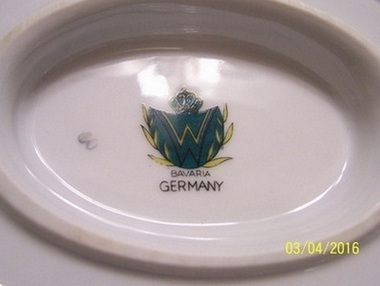I’ve purchased a serving set of Bavarian Germany which consist of a gravy bowl, cream and sugar. I can not indentify the mark. I own both Kovel Porcelain and Pottery books but can not locate the mark that is on my set. I’ve attached a picture of the mark and will appreciate any help anyone can give me.
Thanks,
mns816
. Per Mr. Marshall:
A common drawback of reference books is that they often ignore decoration studio marks, seeing that those companies were not “manufacturers/makers” per main definition. A second – and far more irritating – drawback however is the absence of secondary (sub-brand) marks and alternate marks used for special “factory refurbished” series.
In your case, shown transfer-applied mark is a factory-created cover-up of one of their own marks, normally used to obscure the original maker due to some sort of restrictions – the undermining of retail contracts with regional protection clause, for example. Or a simple quick deal with some retailer or institution without wanting to ruin own reputation or price settings. There are enough examples for such tricks, most of which we still encounter up to this day, like cheap “no name” instant coffee actually made by a very well known A-brand maker and sold well under their regular brand price, for example.
I’m still trying to set up a list of all the different ‘special’ marks this specific manufacturer used over time, hence I don’t have any of these special markings shown online yet. What I can say is that we are talking about a mark used by the factory of Heinrich Winterling from the town of Marktleuthen; this specific version of cover-up was used between 1951 and 1970 (but as it – like its cousins – was constantly re-cycled for mutliple sets, that’s all I can say).
Is there anything he did not cover or that you did not understand ?? He is an expert on porcelain of that area so whatever he said was correct !! I admit sometimes his posts are a bit difficult to understand for some !! Just post his reply and I will try to fill in any blanks if needed !!
And thanks,, this pic was great !!


